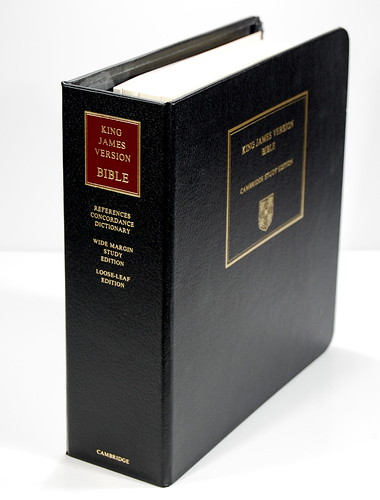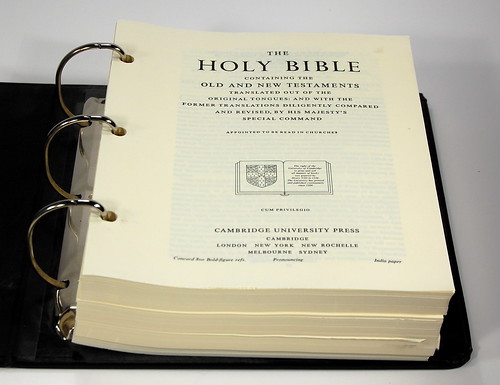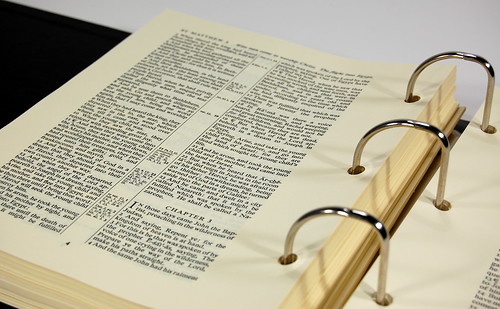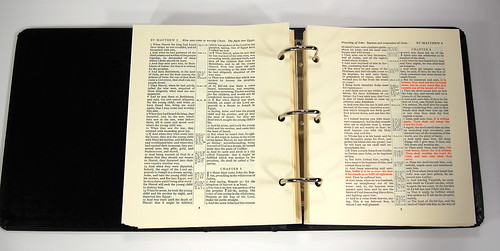Glimpse: Cambridge Loose-Leaf KJV
I'm not a socialist, but I sometimes wish the US government would take charge of the cellular networks, so that we'd get coverage wherever there happen to be roads and competition would focus on building better phones rather than spinning off redundant (and incomplete) networks. Whenever I float this theory -- usually while driving through someplace like Montana where AT&T doesn't seem to think cellular reception is needed -- it usually gets shot down. Even I don't agree with myself entirely, because this rationale sounds a little bit like the argument for why we should only have one Bible translation. And I happen to think that in a multitude of counselors there is wisdom. But there's no denying that when the Authorized Version rules the waves, diversity held sway in the realm of design and binding. Instead of forty translations, each available in black and purple plastic, there were a variety of formats that seems utterly decadent in retrospect. Perfect example: the loose-leaf Bible.
It's exactly what it looks like: a Bible in a three-ring binder. And not some cheap photocopy of an edition, either. This is the real thing, a complete edition of the Concord KJV printed on creme-colored India paper. No wide margins, because it doesn't need them. You can interleave all the notepaper you want ... handwritten jots, typed notes and outlines, printed pages. Knock yourself out. It's wonderful.
The Cambridge Study Edition. I love that, implying as it does that if you're serious about study, you'll need to be able to take your Bible apart and put it back together, along with all kinds of additional material. The rings are large enough to accommodate quite a few additions.
The only mistake here is that the cover page doesn't say "words of Christ in atomic pink." If nothing else, they jump out at you, especially on the creme background.
I don't think you can still get one of these from Cambridge, but there are still loose-leaf editions floating around, including even a loose-leaf edition of the NIV Study Bible, which is pretty sweet. Does anyone out there use one of these? I have to admit, I bought mine with the best intentions and didn't make much use of it. I'm curious if anyone is actually toting a well-interleaved three-ring Bible around.
By the way, if this whets your appetite, take a look at the loose-leaf offerings at ChristianBook.com. I'm amazed these things are still being made. There is even a copy of the New Oxford Annotated NRSV with Apocrypha. I have a feeling none of them are on India paper, though.
J. Mark Bertrand is a novelist and pastor whose writing on Bible design has helped spark a publishing revolution. Mark is the author of Rethinking Worldview: Learning to Think, Live, and Speak in This World (Crossway, 2007), as well as the novels Back on Murder, Pattern of Wounds, and Nothing to Hide—described as a “series worth getting attached to” (Christianity Today) by “a major crime fiction talent” (Weekly Standard) in the vein of Michael Connelly, Ian Rankin, and Henning Mankell.
Mark has a BA in English Literature from Union University, an MFA in Creative Writing from the University of Houston, and an M.Div. from Heidelberg Theological Seminary. Through his influential Bible Design Blog, Mark has championed a new generation of readable Bibles. He is a founding member of the steering committee of the Society of Bible Craftsmanship, and chairs the Society’s Award Committee. His work was featured in the November 2021 issue of FaithLife’s Bible Study Magazine.
Mark also serves on the board of Worldview Academy, where he has been a member of the faculty of theology since 2003. Since 2017, he has been an ordained teaching elder in the Presbyterian Church in America. He and his wife Laurie life in Sioux Falls, South Dakota.





